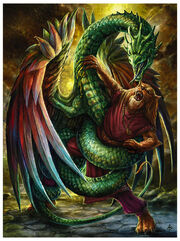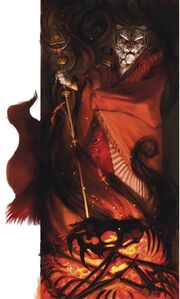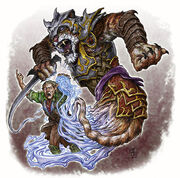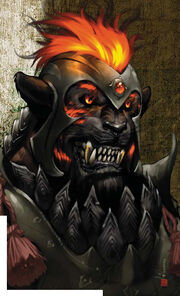Once upon a time, the rakshasas dominated both Khorvaire and Sarlona. However, the dragons of Argonnessen and the couatls of Xen'drik joined forces, and waged a great war against the rakshasas and their rulers, the great rakshasa rajahs. Though the dragons and couatls were victorious, most of the couatls gave their lives to bind the rakshasa rajahs, called the Overlords, deep within the Khyber. A number of rakshasas remain free, and call themselves the Lords of Dust. Their end goal is to free their rajah rulers and avenge themselves against the dragons and the remaining agents of the couatls: the devas.[4][5]
History[]
The Age of Demons[]
During the Age of Dragons, the great dragon Eberron trapped the evil progenitor dragon Khyber within itself, after Khyber slew their sibling Siberys. Khyber's last act of defiance was to give birth to a host of fiends. It was Khyber's last hope that these fiends would destroy the descendants of Siberys and Eberron. 10,000,000 years ago, the fiends succeeded, and led by the rakshasa and night hags, the fiends overran the world of Eberron. Thus began the Age of Demons.[4]
The fiends, in control of Eberron, turned the world into a fiery hell. This new world was ruled by the Overlords, each taking dominion over an aspect of the world. High in power amongst the fiends were the rakshasa.[6]
The Revolt of the Dragons[]
Not completely obliterated, the dragons hid from their demon rulers, living in a primitive state. However, 1,500,000 years ago, the dragons discovered what would be called the Draconic Prophecy. They began to build upon this knowledge, and began to fight against the demons. They found other allies that had also survived; most importantly: the couatls. Once they became powerful enough, the dragons and couatls joined forces and attacked the rakshasa and other fiends that inhabited Eberron.[7]
The Sacrifice of the Couatls[]

A couatl vs. a rakshasa
The couatls sacrificed themselves to send the Overlords and the majority of the fiends back into the Khyber, where they are trapped. However, because the rakshasas were closer in ties to Eberron than other fiends, the couatls found them harder to drive back into the depths. Though they were defeated all the same, a number of rakshasas were not able to be sent back into the Khyber.[7]
When the great war ended, those rakshasa that were not imprisoned in the Khyber retreated back to a land they called Fah'lrrg in the infernal tongue; the land now known as the Demon Wastes. From behind the Shadowcrags and the Icehorn Mountains, the rakshasa and other fiends continued to live within their ruined fortresses and amongst the various pits that still lead into the Khyber.[4]
The Lords of Dust[]

A rakshasa Lord of Dust
Within the Demon Wastes, the remaining rakshasa made plans to free their trapped rajahs. They formed a secret society which they called the Lords of Dust. Led by the Bleak Congress, the rakshasas of the Lords of Dust organized their other Khyber-spawned brethren and led them to infiltrate the rest of the world. The goals of most of the Lords of Dust are to gain revenge on their age old enemies: the dragons and the couatls, and their descendants, especially the Church of the Silver Flame. However, some rakshasa's only goals are to gain power for themselves.[4]
Most of the Lords of Dust also seek to free the imprisoned Overlords from their bonds. They use prakhutus, or speakers, that can communicate with their masters. The prakhutus then carry their rulers' wishes to the rest of the Lords of Dust.[8]
The rakhsasas amongst the Lords of Dust use their telepathy and shape-changing abilities to infiltrate every organization in Eberron. No one is entirely sure what their schemes are. Since the rakhsasas are immortal, their true end goals are hard to decipher. A rakshasa agent might wait an entire human lifetime before making a move to further its schemes. It is thought that the Lords of Dust have managed to infiltrate most organizations, including the Aurum, the Cults of the Dragon Below, the elves of Aerenal, and even House Phiarlan.[4][8][9]
The Lords of Dust also prefer to use the Draconic Prophecy against the dragons. They will manipulate events to resemble events foretold by the Draconic Prophecy, then manipulate the dragons to perform acts they think are part of the prophecy, but are actually detrimental to future events.[6]
The Lords of Dust have a large number of followers. Chief among them are the Claws of Khyber, made up of almost exclusively rakshasa agents. In addition to those agents, the Lords of Dust use humans and exiled demons alike to further their goals.[8]
The Lords of Dust ostensibly operate out of the ancient city of Ashtakala, the "capital" of the Demon Wastes. There, they are members of the Council of Ashtakala, the rulers of the Demon Wastes.[9]
Types of rakshasa[]
Rakshasas, the sorcerers[]
The unnamed sorcerer rakshasas are the masterminds of the Lords of Dust. They focus on learning and improving their spell-like abilities, often taking the path of the sorcerer. They spend their immortal years developing their abilities and accumulating power.
Zakyas, the warriors[]
Unlike the rajahs and the sorcerers, the zakyas relish melee combat. They are masters of melee fighting, and use their spell-like abilities to supplement their hand-to-paw fighting. Zakyas often enter combat with melee weapons, armor, and shields, though if you look close, you can see tufts of fur poking though the gaps of their armor.[11]
Ak'chazars, the loners[]
One type of rakshasas, known as the ak'chazars, act as loners amongst their people. They have all the same abilities as their brethren, but resemble the coloration of white tigers. Some ak'chazars count themselves as members of the Lords of Dust, and at least one ak'chazar is known to be working for the Daughters of Sora Kell deep within the Great Crag of Droaam.[12]
Naztharunes, the sneaks[]
While the ak'chazars resemble a white tiger, the naztharunes resemble a black one. These rakshasa specialize not only in disguise and subterfuge, but also in stealth. They can use their abilities to hide in shadows, and use their spell-like abilities to jump from one shadow to another. They are loyal servants to the rajahs, and specialize in infiltrating the various thieves guilds across Eberron.[12]
Half-Dragon Rakshasas, the half-breeds[]
During the Age of Demons, the draconic followers of Tiamat bred with their fiend allies, and half-dragon rakshasas were born. Most half-dragons work towards the release of Tiamat, though others have allied themselves with the Lords of Dust.[13]
Appearance & Personality[]
The rakshasa appear to be humanoid tigers. They have a humanoid shape, but with a tiger's head. Most rakshasa have the coloration of traditional tigers, except the ak'chazar, which are white, and the naztharune, which are black. They are covered in fur, and have claws on their hands and feet. Upon closer inspection, their hands are actually reversed; the palms of its hands are where the backs of a hand would be on a human. Because of this, they grab items in the opposite direction of a human.
Most rakskasa, with the exception of the zakya and the naztharune, prefer to wear elegant clothes while in their natural forms.[12][14]
Rakshasas are the embodiment of pure evil. They have been manipulating the events of Eberron for hundreds of thousands of years, and cannot be trusted.[4][14]
Abilities[]

A rakshasa escaping its prison
As humanoid tigers, the rakshasa all have the claw and bite attacks one would expect of a tiger; however, rakshasa rarely use these abilities, preferring to use their shape-changing abilities, their telepathy, and their spell-like powers.
All rakshasa have the ability to change their appearance. They can take on the shape of any humanoid, and are masters of disguise. Changes in form cannot be dispelled, however, a rakshasa reveals its true form upon death. True seeing magics have the ability to see a rakshasa in its true form, even while in disguise.
All rakshasas can read the thoughts of any intelligent creature within range. They help use this to increase their ability to assume other creature's form. Intelligent creatures with strong minds can resist a rakshasa's ability to read its thoughts.
Due to their bloodlines, rakshasas are inherent spellcasters. Most rakshasa have the ability to project various spell-like abilities. These include magic attacks (like magic missile) or magic spells (like suggestion).[14]
Though all rakshasa are considered outsiders, they are native to the plane of Eberron. This means that they can be raised, reincarnated, or resurrected upon death.[4] However, there are rumors that if some rakshasa have redeemed themselves, they will be resurrected into the body and lifetime of a deva. However, most devas deny this claim.[5]
Notable Rakshasa[]

Mordakhesh the Shadowsword
While the names of the majority of rakshasa traveling the world of Eberron are unknown, some have surfaced in rumored whispers:
- The most famous of the rakshasa is Durastoran the Wyrmbreaker, a powerful ak'chasar loremaster. Durastoran is leading a more active campaign against the dragons, especially against the Chamber. He is said to have a large force of lesser fiends and humans at his disposal. He enjoys destabilizing the relationship between the dragons and the elves. Durastoran worships one of the Overlords directly, Bel Shalor, the Shadow in the Flame, and seeks a way to free this shadowy demon from his prison. Durastoran sits on the Bleak Council.[8][9][15]
- The greatest of the prakhutu is Hektula, the Bloody Scribe. Hektula is the prakhutu of Overlord Sul Khatesh, and serves the Council of Ashtakala as their librarian. She is one of the most knowledgeable arcanists on Eberron, and sits on the Bleak Council.[8]
- Kashtarhak, known as the Voice of Chaos, serves the trapped rajah Eldrantulku. it is said that Kashtarhak helped manipulate the fall of the giants of Xen'drik, the destruction of the Dhakaani Empire, and the fall of the Kingdom of Galifar. He sits on the Bleak Council.[8]
- The most powerful of all the zakyas is Mordakhesh, the Shadowsword. Mordakhesh has fought dragons in melee combat, and was one of the fiercest fighters for the Overlords. Mordakhesh prefers manipulating armies, and has spies amongst most armies of Khorvaire. He is a servant of Overlord Rak Tulkhesh, and has a legion of lesser fiends and barbarians at his disposal. He sits on the Bleak Council.[8][16]
- Ethon Panjilcuttra is the artificer of the Lords of Dust, who maintains the Drain Works of Ashtakala.[17]
- A rakshasa named Zathara and his zakya assistant Nethatar act as the Lords of Dust's agents in Sharn, the City of Towers. They make their base of operations within a wizard's keep in Khyber's Gate.[18]
- Kkressd is a rakshasa disguised as a House Orien courier. He is the leader of the Dust Motes, a subgroup of the Lords of Dust, and has been courting Jorlanna d'Cannith.[19]
- Kashurashan is a rakshasa sorcerer who has been watching the city of Stormreach in Xen'drik since before the fall of the giants.[20]
- A rakshasa named Tyrankalis aided the giants against the Quori, but was tricked by the giants and entrapped within an amulet.[21]
- A rakshasa noble named Zathasram has taken up residence in the Maze of Shattered Souls, a hidden ruin in the Demon Wastes. Zathasram is seeking to amass enough power and knowledge to become the exarch of the Stalker in Darkness.[22]
- Vikari is a zakya rakshasa in charge of the Pilfered Wand, a group of arcane thieves.[23]
- the Eberron novels.
- A powerful rakshasa named Drulkalatar has shown interest in the agent of the Dark Lanterns known as Thorn.[24][25]
Appendix[]
External Links[]
- Rakshasa article at the Forgotten Realms Wiki, a wiki for the Forgotten Realms campaign setting.
References[]
- ↑ Mike Mearls, Jeremy Crawford, Christopher Perkins (2014). Monster Manual (5th Edition). (Wizards of the Coast), p. 257. ISBN 978-0786965614.
- ↑ Mike Mearls, Stephen Schubert, and James Wyatt (2008). Monster Manual (4th edition). (Wizards of the Coast), pp. 216–218. ISBN 0-7869-4852-3.
- ↑ Skip Williams, Jonathan Tweet, and Monte Cook (July 2003). Monster Manual (3.5 edition). (Wizards of the Coast), pp. 211–212. ISBN 0-7869-2893-X.
- ↑ 4.0 4.1 4.2 4.3 4.4 4.5 4.6 Keith Baker, Bill Slavicsek, & James Wyatt (2004). Eberron Campaign Setting. (Wizards of the Coast), pp. 242–243. ISBN 0-7869-3274-0.
- ↑ 5.0 5.1 David Noonan, Ari Marmell, and Robert J. Schwalb (2009). Eberron Player's Guide. (Wizards of the Coast), p. 34. ISBN 0-7869-5100-1.
- ↑ 6.0 6.1 Keith Baker, Scott Fitzgerald Gray, Nicolas Logue, & Amber Scott (2007). Dragons of Eberron. (Wizards of the Coast), p. 8. ISBN 0-7869-4154-5.
- ↑ 7.0 7.1 Keith Baker, Bill Slavicsek, & James Wyatt (2004). Eberron Campaign Setting. (Wizards of the Coast), p. 224. ISBN 0-7869-3274-0.
- ↑ 8.0 8.1 8.2 8.3 8.4 8.5 8.6 Keith Baker (November 2005). “Eternal Evil: The Lords of Dust”. In Erik Mona ed. Dragon #337 (Paizo Publishing), p. 56–70.
- ↑ 9.0 9.1 9.2 James Wyatt and Keith Baker (2009). Eberron Campaign Guide. (Wizards of the Coast), pp. 28–31. ISBN 0-7869-5099-4.
- ↑ Keith Baker, Jeremy Crawford, & James Wyatt (2019). Eberron: Rising from the Last War. (Wizards of the Coast), p. 309. ISBN 0786966890.
- ↑ 11.0 11.1 Keith Baker, Bill Slavicsek, & James Wyatt (2004). Eberron Campaign Setting. (Wizards of the Coast), pp. 297–298. ISBN 0-7869-3274-0.
- ↑ 12.0 12.1 12.2 12.3 Andrew Finch, Gwendolyn F.M. Kestrel, Chris Perkins (August 2004). Monster Manual III. (Wizards of the Coast), pp. 136–137. ISBN 0-7869-3430-1.
- ↑ Keith Baker, Scott Fitzgerald Gray, Nicolas Logue, & Amber Scott (2007). Dragons of Eberron. (Wizards of the Coast), p. 60. ISBN 0-7869-4154-5.
- ↑ 14.0 14.1 14.2 Skip Williams, Jonathan Tweet, and Monte Cook (July 2003). Monster Manual (3.5 edition). (Wizards of the Coast), p. ?. ISBN 0-7869-2893-X.
- ↑ Keith Baker, Scott Fitzgerald Gray, Nicolas Logue, & Amber Scott (2007). Dragons of Eberron. (Wizards of the Coast), p. 20. ISBN 0-7869-4154-5.
- ↑ Keith Baker, Jeremy Crawford, & James Wyatt (2019). Eberron: Rising from the Last War. (Wizards of the Coast), p. 301. ISBN 0786966890.
- ↑ David Noonan, Rich Burlew, & Frank Brunner (2005). Explorer's Handbook. (Wizards of the Coast), p. 113. ISBN 0-7869-3691-6.
- ↑ Keith Baker & James Wyatt (2004). Sharn: City of Towers. (Wizards of the Coast), pp. 101–102. ISBN 0-7869-3434-4.
- ↑ Bill Slavicsek, David Noonan, and Christopher Perkins (2005). Five Nations. (Wizards of the Coast), p. 20. ISBN 0-7869-3690-8.
- ↑ Keith Baker, Nicolas Logue, James Desborough, C.A. Suleiman (2008). City of Stormreach. (Wizards of the Coast), p. 58. ISBN 0-7869-4803-5.
- ↑ Craig Shackleton (June 2007). “The Aundairian Job”. Dungeon #147 (Paizo Publishing) (147)..
- ↑ James Wyatt (April 2010). “The Maze of Shattered Souls” (PDF). Dungeon #177 (Wizards of the Coast) (177)..
- ↑ Christopher Wissel (February 2007). “Riding the Rail”. Dungeon #143 (Paizo Publishing) (143)..
- ↑ Keith Baker (November 2008). The Queen of Stone. (Wizards of the Coast). ISBN 978-0-7869-5009-6.
- ↑ Keith Baker (November 2009). Son of Khyber. (Wizards of the Coast). ISBN 0-7869-5234-2.
